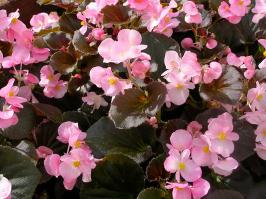Alternatives to impatiens
29
May 2014
By: sharon
2 Comments
Have you heard about the impatiens problem in recent years? Although our seed companies are saying this year it is “clean seed” this year, many are still going with different options for the shade. To help you out here is a list of some of the alternatives to seed impatiens.
Some Impatien replacements
| Scientific Name. Common Name. Notes. | |
 |
Alpinia zerumbet. Shell ginger. It is used for its interesting foliage and prefers part, not full shade. Photo credit: Rebecca Finneran, Michigan State University. |
 |
Alternanthera species. Joseph’s Coat. It is used for its colorful foliage and has many color options. Shown here is a ‘black’ variety but colors also include two tones of green, yellow, and white, among others. Photo credit: Erik Runkle, Michigan State University. |
 |
Begonia rex hybrids. Rex begonia or painted begonia. It is used for its colorful foliage and can include tones of red, green, and silver. Photo credit: Rebecca Finneran, Michigan State University |
 |
Begonia x hiemalis. Hiemalis begonia or Rieger begonia. This comes in a variety of flower colors including red, pink, yellow, and white. Flowers are large and showy. Photo credit: Erik Runkle, Michigan State University.
|
 |
Begonia x semperflorens-cultorum . Wax begonia, or bedding begonia, or fibrous-rooted begonia. This comes in a wide range of flower colors with green or dark purpe leaves. Photo credit: Missouri Botanical Garden. |
 |
Begonia x tuberhybrida. Tuberous begonia. These plants are generally quite large with showy flowers, but flowering of some varieties stops during the long days of summer. Photo credit: Missouri Botanical Garden. |
 |
Browallia speciosa. Browallia. Usually has white or shades of blue or purple flowers. Does not do well during periods of cool weather. Photo credit: Missouri Botanical Gardens. |
 |
Caladium bicolor. Angel-wings. It is used for its colorful foliage. Leaves are often very large and do best in warm climates. Photo credit: Missouri Botanical Gardens. |
 |
Dichondra argentea. Dichondra. It is used for its foliage and performs best in partial shade as a groundcover, in a container, or in a hanging basket. Photo credit: Missouri Botanical Gardens. |
 |
Fuchsia x hybrida. Fuchsia. Some are best used in containers or hanging baskets, but upright varieties can do well in the landscape. Flowers can be solid or a bicolor red, purple, pink, or white, among others. Photo credit: Michigan State University Trial Gardens. |
 |
Heliotropium arborescens. Heliotrope. Is best used in partial shade with moist, but not wet soils. Photo credit: Missouri Botanical Gardens. |
| Hypoestes phyllostachya. Polka dot plant. It is used for its colorful, mottled foliage with pink, red, or white. Plants can tolerate high light and can be trimmed in the garden if desired. Photo credit: Missouri Botanical Gardens. | |
 |
Impatiens hawkeri. New Guinea impatiens. Have larger flowers and leaves than garden impatiens, but do not grow as quickly. Some newer varieties have spreading habit. Photo credit: Erik Runkle, Michigan State University. |
 |
Ipomea batatas. Sweet potato vine. It is best used in partial, not full shade and is used for its colorful foliage, which has many variations. Very easy to grow and can be somewhat aggressive. Photo credit: Michigan State University Trial Gardens. |
 |
Lobelia species. Lobelia or cardinal flower. Prefers partial, not full shade. Spreading varieties have blue, pink, or white flowers whereas upright varieties often have red or white flowers. Photo credit: Michigan State University Trial Gardens. |
 |
Lobularia maritima. Alyssum or sweet alyssum. Prefers partial, not full shade but most varieties do not tolerate the heat of summer. Photo credit: Michigan State University Trial Gardens. |
 |
Oxalis species. Oxalis or shamrock or wood sorrel. Easy to grow but most varieties can be invasive because of self seeding. Photo credit: Rebecca Finneran, Michigan State University. |
 |
Pelargonium peltatum. Ivy geranium. Prefers partial, not full shade and is best used in containers or hanging baskets. All but a few recently introduced varieties do not tolerate high temperatures. Photo credit: Erik Runkle, Michigan State University. |
| Perilla frutescens. Perilla. Is used for its colorful foliage and comes in a variety of colors. Tolerates the heat well. Photo credit: Michigan State University Trial Gardens. | |
 |
Plectranthus species. Plectranthus or Swedish ivy. It is used for its colorful foliage and prefers partial, not full shade. Some newer varieties are grown more for their colorful flowers. Photo credit: Missouri Botanical Garden. |
 |
Salvia farinacea. Mealycup sage. This plant prefers partial, not full shade and tolerates poor soils and some drought. Flower colors are available in blue, purple, lavender, and white. Photo credit: Missouri Botanical Garden. |
 |
Salvia splendens. Salvia or scarlet sage. This plant prefers partial, not full shade and usually has red, pink, or white flowers. Photo credit: Kristin Getter, Michigan State University. |
 |
Solenostemon scutellarioides. Coleus. It is used for its colorful foliage, and comes in many different colors and heights. Can tolerate full sun to deep shade. Photo credit: Michigan State University Trial Gardens. |
 |
Torenia fournieri. Wishbone flower. Performs best in partial, not deep shade. Comes in a range of single and multi-colored flowers with shades of blue, purple, and yellow, among others. Photo credit: Michigan State University Trial Gardens. |
 |
Alpinia zerumbet. Shell ginger. It is used for its interesting foliage and prefers part, not full shade. Photo credit: Rebecca Finneran, Michigan State University. |







